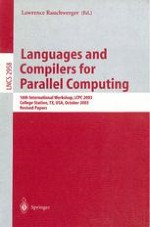This book constitutes the thoroughly refereed post-proceedings of the 16th International Workshop on Languages and Compilers for Parallel Computing, LCPC 2003, held in College Station, Texas, USA, in October 2003.
The 35 revised full papers presented were selected from 48 submissions during two rounds of reviewing and improvement upon presentation at the workshop. The papers are organized in topical sections on adaptive optimization, data locality, parallel languages, high-level transformations, embedded systems, distributed systems software, low-level transformations, compiling for novel architectures, and optimization infrastructure.
